Treaty of Jaffa may refer to:
- Treaty of Jaffa (1192), ended the Third Crusade
- Treaty of Jaffa (1229), ended the Sixth Crusade
Treaty of Jaffa may refer to:

The Kingdom of Jerusalem, officially known as the Latin Kingdom of Jerusalem or the Frankish Kingdom of Palestine, was a Crusader state established in the Southern Levant by Godfrey of Bouillon in 1099 after the First Crusade. The kingdom lasted nearly two hundred years, from 1099 until 1291 when its last remaining possession, Acre, was destroyed by the Mamluks. Its history is divided into two distinct periods.

The 12th century is the period from 1101 to 1200 in accordance with the Julian calendar. In the history of European culture, this period is considered part of the High Middle Ages and is sometimes called the Age of the Cistercians. The Golden Age of Islam experienced a significant development, particularly in Islamic Spain.
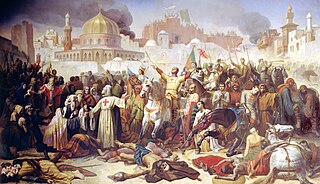
Year 1099 (MXCIX) was a common year starting on Saturday of the Julian calendar.

Year 1229 (MCCXXIX) was a common year starting on Monday of the Julian calendar.

The Sixth Crusade (1228–1229), also known as the Crusade of Frederick II, was a military expedition to recapture Jerusalem and the rest of the Holy Land. It began seven years after the failure of the Fifth Crusade and involved very little actual fighting. The diplomatic maneuvering of the Holy Roman Emperor and King of Sicily, Frederick II, resulted in the Kingdom of Jerusalem regaining some control over Jerusalem for much of the ensuing fifteen years as well as over other areas of the Holy Land.

The Third Crusade (1189–1192) was an attempt by three European monarchs of Western Christianity to reconquer the Holy Land following the capture of Jerusalem by the Ayyubid sultan Saladin in 1187. For this reason, the Third Crusade is also known as the Kings' Crusade.

The Eighth Crusade was the second Crusade launched by Louis IX of France, this one against the Hafsid dynasty in Tunisia in 1270. It is also known as the Crusade of Louis IX against Tunis or the Second Crusade of Louis. The Crusade did not see any significant fighting as King Louis died of dysentery shortly after arriving on the shores of Tunisia. The Treaty of Tunis was negotiated between the Crusaders and the Hafsids. No changes in territory occurred, though there were commercial and some political rights granted to the Christians. The latter withdrew back to Europe soon after.
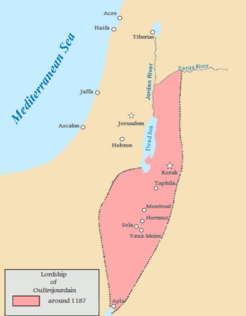
The Lordship of Oultrejordain or Oultrejourdain was the name used during the Crusades for an extensive and partly undefined region to the east of the Jordan River, an area known in ancient times as Edom and Moab. It was also referred to as Transjordan.
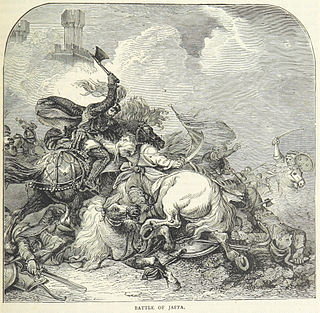
The Battle of Jaffa took place during the Crusades, as one of a series of campaigns between the army of Sultan Saladin and the Crusader forces led by King Richard I of England. It was the final battle of the Third Crusade, after which Saladin and King Richard were able to negotiate a truce. Although the Crusaders did not regain possession of Jerusalem, Christian pilgrims were permitted entry into the city, and the Crusaders were able to retain control of a sizable strip of land stretching from Beirut to Jaffa.
The Crusades were a series of religious wars initiated, supported, and sometimes directed by the Latin Church in the medieval period. The best known of these Crusades are those to the Holy Land in the period between 1095 and 1291 that were intended to recover Jerusalem and its surrounding area from Islamic rule. Beginning with the First Crusade, which resulted in the recovery of Jerusalem in 1099, dozens of Crusades were fought, providing a focal point of European history for centuries.
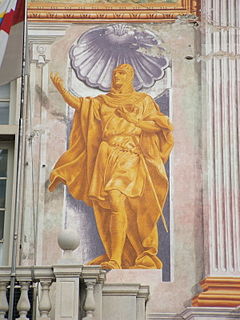
Guglielmo Embriaco, was a Genoese merchant and military leader who came to the assistance of the Crusader States in the aftermath of the First Crusade. Embriaco is considered one of the founders of what would become the Republic of Genoa.
Events from the 1190s in England.
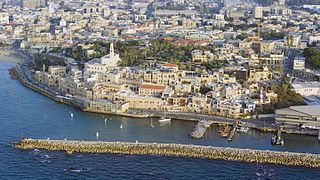
Jaffa, in Hebrew Yafo and in Arabic Yafa and also called Japho or Joppa, the southern and oldest part of Tel Aviv-Yafo, is an ancient port city in Israel. Jaffa is known for its association with the biblical stories of Jonah, Solomon and Saint Peter as well as the mythological story of Andromeda and Perseus, and later for its oranges.
Jaffa is part of the city of Tel Aviv in Israel.
The Treaty of Jaffa, more seldom referred to as the Treaty of Ramla or the treaty of 1192, was a truce agreed to during the Crusades. It was signed on 1 or 2 September 1192 A.D. between the Muslim ruler Saladin and Richard the Lionheart, King of England, shortly after the July–August 1192 Battle of Jaffa. The treaty, negotiated with the help of Balian of Ibelin, guaranteed a three-year truce between the two armies. This treaty ended the Third Crusade.
Hugh de Puiset, Hugh du Puiset or Hugh de Le Puiset may refer to several medieval men:

The Barons' Crusade (1239–1241), also called the Crusade of 1239, was a crusade to the Holy Land that, in territorial terms, was the most successful crusade since the First Crusade. Called by Pope Gregory IX, the Barons' Crusade broadly embodied the highest point of papal endeavor "to make crusading a universal Christian undertaking." Gregory IX called for a crusade in France, England, and Hungary with different degrees of success. Although the crusaders did not achieve any glorious military victories, they used diplomacy to successfully play the two warring factions of the Ayyubid dynasty against one another for even more concessions than Frederick II had gained during the more well-known Sixth Crusade. For a few years, the Barons' Crusade returned the Kingdom of Jerusalem to its largest size since 1187.
The Battle at Gaza took place on 13 November 1239 as part of the Barons' Crusade. In it, an army led by Theobald I of Navarre was defeated by the Egyptian Ayyubids.
The siege of Damascus of 1229 was part of an Ayyubid succession war over Damascus that broke out following the death of al-Muʿaẓẓam I in 1227. The late ruler's son, al-Nāṣir Dāʾūd, took de facto control of the city in opposition to al-Kāmil, the Ayyubid sultan in Egypt. In the ensuing war, al-Nāṣir lost Damascus but preserved his autonomy, ruling from al-Karak.

The Treaty of Jaffa, sometimes the Treaty of Jaffa and Tall al-ʿAjūl, was an agreement signed on 18 February 1229 between Frederick II, Holy Roman emperor and king of Sicily, and al-Kāmil, Ayyubid sultan of Egypt. It brought an end to the Sixth Crusade, led by Frederick, by restoring the city of Jerusalem and a few other territories to the Kingdom of Jerusalem, whose king at the time was Frederick's infant son Conrad.